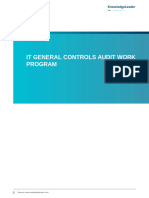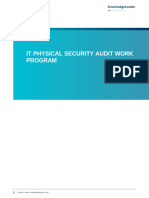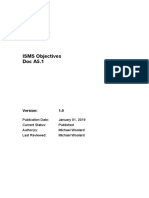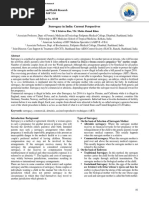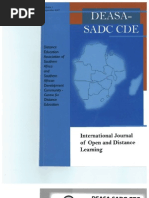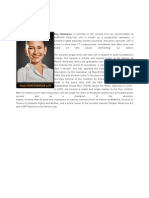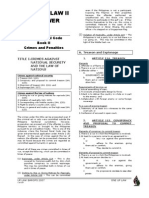Information Technology Audit Methodology:: Planning Phase
Information Technology Audit Methodology:: Planning Phase
Uploaded by
shakawathCopyright:
Available Formats
Information Technology Audit Methodology:: Planning Phase
Information Technology Audit Methodology:: Planning Phase
Uploaded by
shakawathOriginal Description:
Original Title
Copyright
Available Formats
Share this document
Did you find this document useful?
Is this content inappropriate?
Copyright:
Available Formats
Information Technology Audit Methodology:: Planning Phase
Information Technology Audit Methodology:: Planning Phase
Uploaded by
shakawathCopyright:
Available Formats
Information Technology Audit Methodology:
Planning Phase
Determine Define Audit Set Audit Perform Pre Determine
Audit Subject Objective Scope audit Planning Procedures
Fieldwork and Documentation Phase
Acquire Data Test Existing Issue Discovery Document Results
Controls and Validation
Reporting Phase
Gather Report Draft Report Issue Report Follow-up
Requirements
1. Determine audit subject: Identify the area to be audited (e.g., business function, system,
physical location).
2. Define audit objective: Identify the purpose of the audit. For example, an objective might be
to determine whether program source code changes occur in a well-defined and controlled
environment.
3. Set audit scope: Identify the specific systems, function or unit of the organization to be
included in the review. For example, in the previous example (program changes), the scope
statement might limit the review to a single application, system or a limited period of time.
This step is very important because the IS auditor will need to understand the IT environment
and its components to identify the resources that will be required to conduct a comprehensive
evaluation.
A clear scope will help the IS auditor define a set of testing points that is relevant to the audit and
further determine the technical skills and resources necessary to evaluate different technologies
and their components
4. Perform pre-audit planning:
Sami Tech Ltd
• Conduct a risk assessment, which is critical in setting the final scope of a risk-based audit. For
other types of audits (e.g., compliance), conducting a risk assessment is a good practice because
the results can help the IS audit team to justify the engagement and further refine the scope and
preplanning focus.
• Interview the auditee to inquire about activities or areas of concern that should be included in
the scope of the engagement.
• Identify regulatory compliance requirements.
• Once the subject, objective and scope are defined, the audit team can identify the resources
that will be needed to perform the audit work. Some of the resources that need to be defined
follow:
– Technical skills and resources needed
– Budget and effort needed to complete the engagement
– Locations or facilities to be audited
– Roles and responsibilities among the audit team
– Time frame for the various stages of the audit
– Sources of information for test or review, such as functional flowcharts, policies, standards,
procedures and prior audit work papers
– Points of contact for administrative and logistics arrangements
– A communication plan that describes to whom to communicate, when, how often and for what
purposes
5. Determine audit procedures and steps for data gathering:
At this stage of the audit process, the audit team should have enough information to identify and
select the audit approach or strategy and start developing the audit program.
Some of the specific activities in this step are:
• Identify and obtain departmental policies, standards and guidelines for review.
• Identify any regulatory compliance requirements.
• Identify a list of individuals to interview.
• Identify methods (including tools) to perform the evaluation.
• Develop audit tools and methodology to test and verify controls.
• Develop test scripts.
• Identify criteria for evaluating the test.
• Define a methodology to evaluate that the test and its results are accurate (and repeatable if
necessary).
Sami Tech Ltd
Scope of Work:
Sr No. Scope of Services
1 Governance and Management of IT
2 Information Systems Acquisition, Development and Implementation
3 Information Systems Operations, Maintenance & Support
4 Protection of Information Assets
5 Change Management
6 Logical and Physical Access
7 Backup and Recovery of Data
8 Scheduling Jobs
9 Incident and Problem Management
10 Virus Protection
11 Network Communications Security
12 Data Centre
13 IT business continuity and disaster recovery
14 Platform review of the relevant OS and databases
15 ICT Security Policy
16 Segregation of Duties (SoD)
Sami Tech Ltd
List of Reviewed Documents
SL# Documents
1 ''ICT Security Policy''.
2 Organogram chart of ICT department including job description, segregation of duties and fallback plan.
3 Branch organogram with ICT support unit.
4 Scheduled roster for ICT personnel
5 Internal and/or external IS audit report for last year, audited branch list, copy of profile of IS auditor.
6 Information Security Training documents for last period, copy of yearly training plan, List of participants.
7 Problem management log for a specific period of time, Problem management system or related
software information.
8a Assessment of the risk
8b Identification of mitigation control
8c Remedial plan to reduce the risk
9 Approval of the risk acknowledgement from the owner of the risk
10 IT based/enabled product list [marked recently launched (if any) product], list of upcoming products.
11 List of software (in house and purchased).
12 Document of change procedure for IS (Documentation about –Necessary change details in production
environment, Audit log of changes)
13 User Acceptance Test (UAT) for changes
14 Inventory list of all ICT assets
15 Software licenses (OS, DB, Anti-Virus, MS Office, etc.)
16 Operating procedure (Operating procedure for the users, Scheduling process, system start-up, close
down, restart, recovery process.)
17 Handling of exception condition.
18 Secure disposal policy
19 Active Directory and password control policy
20 Approval procedure/authorization matrix/delegation of authority for CBS
21 Audit trail report including user ID, authorizer ID and date-time stamp for CBS for a particular period of
time
22 Network design document (should contain protocols and security features)
23 Email and internet usage policy
24 Technical document of Mobile Banking, Mobile banking policy (if applicable).
25 Outsourced software documentation (any one related to banking application)
26 Business Continuity Plan
27 Backup and restore log
28 Disaster Recovery test report, list of available software in DR site.
29 SLA with software vendor and connectivity provider
30 Documentation about—Total Bandwidth used, No of Fiber communication link with vendor name,
Network security devices
31 Annual fire testing report
32 Copy of self-assessment of Anti-Fraud Internal Control.
Sami Tech Ltd
You might also like
- AnswersDocument21 pagesAnswersAman PrasadNo ratings yet
- The Quran Memorization E-BookDocument60 pagesThe Quran Memorization E-Bookshakawath100% (4)
- Cloud Computing Audit Program - FinalDocument5 pagesCloud Computing Audit Program - FinalRuben100% (1)
- IT Knowledge - Testing GITCs Over Utility Tools v2023Document12 pagesIT Knowledge - Testing GITCs Over Utility Tools v2023DELTON ZARANYIKANo ratings yet
- ITAF-4th-Edition Witaf4 FMK Eng 1020 PDFDocument106 pagesITAF-4th-Edition Witaf4 FMK Eng 1020 PDFEric Noel100% (7)
- IS Audit Checklist in ExcelDocument11 pagesIS Audit Checklist in ExcelAnand.Sonie100% (3)
- IT Risk Management - Audit Program - FinalDocument15 pagesIT Risk Management - Audit Program - FinalST KnightNo ratings yet
- 20 CIS Controls v7.0Document12 pages20 CIS Controls v7.0gpo9141No ratings yet
- Auditing Business Continuity PlanDocument2 pagesAuditing Business Continuity PlanRAJESH UPADHYAYNo ratings yet
- CISSP Domain 1Document142 pagesCISSP Domain 1shakawathNo ratings yet
- It Risk Assessment ToolkitDocument22 pagesIt Risk Assessment Toolkitdeanova88100% (3)
- Auditing IT Governance ControlsDocument55 pagesAuditing IT Governance ControlsLouella Vea HernandezNo ratings yet
- 3rd Party Outsourcing Information Security Assessment Questionnaire V1.4Document10 pages3rd Party Outsourcing Information Security Assessment Questionnaire V1.4Ryan GlasgowNo ratings yet
- ISMS Implementation ChecklistDocument3 pagesISMS Implementation ChecklistAiswarya RajendranNo ratings yet
- Cloud Controls and ISO 27017 ListDocument40 pagesCloud Controls and ISO 27017 ListOscar MalaverNo ratings yet
- Checklist ISO 27001Document6 pagesChecklist ISO 27001Sheik MohaideenNo ratings yet
- Hippa and ISO MappingDocument13 pagesHippa and ISO Mappingnidelel214No ratings yet
- Cybersecurity-Related Policies and Issuances: Developed by The Dod Deputy Cio For CybersecurityDocument1 pageCybersecurity-Related Policies and Issuances: Developed by The Dod Deputy Cio For CybersecurityVandoir Goncalves100% (1)
- 10 Security Risks and Limitations of Cloud ComputingDocument12 pages10 Security Risks and Limitations of Cloud Computingbaye omar SoceNo ratings yet
- Self-Assessment Questionnaire: ISO/IEC 27001:2013 Information Security Management SystemDocument4 pagesSelf-Assessment Questionnaire: ISO/IEC 27001:2013 Information Security Management Systemhendry syahrialNo ratings yet
- Annexure 3.2 - TPRM Checklist For Collection VendorsDocument4 pagesAnnexure 3.2 - TPRM Checklist For Collection Vendorshp agencyNo ratings yet
- ASI - IT Risk and ControlsDocument19 pagesASI - IT Risk and ControlsArthia RuthNo ratings yet
- ITA IT Risk Assessment MatrixDocument36 pagesITA IT Risk Assessment MatrixSuleyman S. GulcanNo ratings yet
- Great Cybersecurity Frameworks: 1.0, 11.12.2023, Andrey ProzorovDocument74 pagesGreat Cybersecurity Frameworks: 1.0, 11.12.2023, Andrey ProzorovVijay Anandhan TDNo ratings yet
- Business Process Audit Guides Information Technology Management 0.process OverviewDocument25 pagesBusiness Process Audit Guides Information Technology Management 0.process OverviewJulio Cubias100% (1)
- ISMS Control of Risks and OpportunitiesDocument6 pagesISMS Control of Risks and OpportunitiesAmine RachedNo ratings yet
- Network Security PolicyDocument6 pagesNetwork Security PolicyKamrul HasanNo ratings yet
- Vendor Risk Management - Contracts - SLAs & Tasks Step-by-Step TutorialDocument26 pagesVendor Risk Management - Contracts - SLAs & Tasks Step-by-Step TutorialKumar AdityaNo ratings yet
- Third Party Assurance QuestionnaireDocument38 pagesThird Party Assurance Questionnaireholamundo123No ratings yet
- Security Control TypesDocument4 pagesSecurity Control Types3LIX 311100% (1)
- ISMS RequirementsDocument6 pagesISMS RequirementsWellington Watanabe Filho100% (1)
- Cybersecurity and Privacy Risk Management Standard FrameworkDocument2 pagesCybersecurity and Privacy Risk Management Standard FrameworkAkhtarul Islam100% (1)
- IT General Controls Audit Work ProgramDocument15 pagesIT General Controls Audit Work Programchinhgpt189No ratings yet
- 19 Cryptography Policy ISODocument3 pages19 Cryptography Policy ISOMuhammad AmmadNo ratings yet
- ISO 27001 Security Compliance PDFDocument15 pagesISO 27001 Security Compliance PDFPraveen KumarNo ratings yet
- Integrated Controls ManagementDocument22 pagesIntegrated Controls ManagementPaulNo ratings yet
- IT Examination ToolkitDocument70 pagesIT Examination ToolkitPab Ronald CalanocNo ratings yet
- Cybersecurity Sample 1Document14 pagesCybersecurity Sample 1Yao Xia LiNo ratings yet
- 3 - AI Acceptable Use PolicyDocument5 pages3 - AI Acceptable Use Policyalreig2No ratings yet
- NIST CSF Checklist PMDocument60 pagesNIST CSF Checklist PMpraneeth.marpallyNo ratings yet
- How To Build Effective Third Party Risk MetricsDocument14 pagesHow To Build Effective Third Party Risk MetricsBogna PiNo ratings yet
- C2M2 Cheat Sheet V1 - Aug 13 2022Document2 pagesC2M2 Cheat Sheet V1 - Aug 13 2022Raúl Alejandro Trigos AngaritaNo ratings yet
- IT Governance Information Security GovernanceDocument57 pagesIT Governance Information Security GovernancePanduNo ratings yet
- The It Audit ProcessDocument38 pagesThe It Audit Processalbert moldon100% (1)
- 13 Effective Security Controls For ISO 27001 ComplianceDocument55 pages13 Effective Security Controls For ISO 27001 ComplianceRobert Mota HawksNo ratings yet
- Asset List For 27001 Risk Assessment ENDocument3 pagesAsset List For 27001 Risk Assessment ENalbertopazminoNo ratings yet
- ISMS-102 - Technical Controls Standards v1.0Document6 pagesISMS-102 - Technical Controls Standards v1.0O GoogleNo ratings yet
- People and Organisational DocumentDocument11 pagesPeople and Organisational DocumentRavi RamanNo ratings yet
- Common Iso 27001 Gaps Issa0111Document4 pagesCommon Iso 27001 Gaps Issa0111nishu128No ratings yet
- Building An ISO 27001-Compliant Cybersecurity Program: Getting StartedDocument2 pagesBuilding An ISO 27001-Compliant Cybersecurity Program: Getting StartedMarcio Rodrigues100% (3)
- IT Physical Security Audit Work ProgramDocument49 pagesIT Physical Security Audit Work Programchinhgpt189No ratings yet
- GAP Analysis V1Document79 pagesGAP Analysis V1vasidharta100% (1)
- Cloud Computing Risk IntelligenceDocument2 pagesCloud Computing Risk IntelligencemattsaavedradNo ratings yet
- Disaster Recovery Audit Work Program - 0Document34 pagesDisaster Recovery Audit Work Program - 0chinhgpt189No ratings yet
- Lesson 3 IT Aufit Development PlanDocument37 pagesLesson 3 IT Aufit Development Planpascal ianNo ratings yet
- IC ISO 27001 Risk Assessment 10839Document2 pagesIC ISO 27001 Risk Assessment 10839Maxedus DotaNo ratings yet
- Asset List For 27001 Risk Assessment ENDocument3 pagesAsset List For 27001 Risk Assessment ENLakshman Kumar100% (1)
- ISO 27001 Documentation - SecureframeDocument1 pageISO 27001 Documentation - SecureframeLETSOGILENo ratings yet
- A5.1 Objectives - v1Document5 pagesA5.1 Objectives - v1Jerome MamauagNo ratings yet
- Iso 27001Document35 pagesIso 27001Ankita SinghNo ratings yet
- Report Cybersecurity-Audit Template enDocument11 pagesReport Cybersecurity-Audit Template enVagabond PakistanNo ratings yet
- ExamPasserListMembers 207Document72 pagesExamPasserListMembers 207shakawathNo ratings yet
- Very Important Audit - ChecklistDocument28 pagesVery Important Audit - Checklistshakawath100% (3)
- A Systematic Approach To Ensuring GDPR Compliance: Key Action Items For Telecom OperatorsDocument6 pagesA Systematic Approach To Ensuring GDPR Compliance: Key Action Items For Telecom OperatorsshakawathNo ratings yet
- OBL RFP For PCI DSSDocument37 pagesOBL RFP For PCI DSSshakawathNo ratings yet
- STL ProfileDocument27 pagesSTL ProfileshakawathNo ratings yet
- How End-To-End Automation Enables Business TransformationDocument11 pagesHow End-To-End Automation Enables Business TransformationshakawathNo ratings yet
- Sra Tool: See The Sra Tool User Guide Available For Download On Healthit - Gov For More Detailed Instructions and FaqsDocument64 pagesSra Tool: See The Sra Tool User Guide Available For Download On Healthit - Gov For More Detailed Instructions and FaqsshakawathNo ratings yet
- OffSec Web Application Security060320Document12 pagesOffSec Web Application Security060320shakawathNo ratings yet
- SOC AS A ServiceDocument12 pagesSOC AS A Serviceshakawath75% (4)
- Match No. Time (Local) Date Teams Venue: Group DivisionDocument2 pagesMatch No. Time (Local) Date Teams Venue: Group DivisionshakawathNo ratings yet
- GuidelinesForApplicationSoftwareTesting HongKongDocument57 pagesGuidelinesForApplicationSoftwareTesting HongKongshakawathNo ratings yet
- PhylosophersAndGod PDFDocument275 pagesPhylosophersAndGod PDFshakawath100% (1)
- Acunetix Web Application Vulnerability Report 2019 PDFDocument27 pagesAcunetix Web Application Vulnerability Report 2019 PDFshakawathNo ratings yet
- Bangladesh Financial Intelligence Unit: Guidelines On Electronic Know Your Customer (e-KYC)Document37 pagesBangladesh Financial Intelligence Unit: Guidelines On Electronic Know Your Customer (e-KYC)shakawathNo ratings yet
- 6th Edition PBDs - GoodsDocument41 pages6th Edition PBDs - Goodsdrpjgmrmc bacNo ratings yet
- themes in betrayal in the city by Francis imbugaDocument3 pagesthemes in betrayal in the city by Francis imbugasimionmariita038No ratings yet
- Banking CompaniesDocument68 pagesBanking CompaniesKiran100% (2)
- The Effectiveness of Internal Controls in Revenue Management A Case Study of Zimbabwe Revenue Authority (ZIMRA) (2011-2012)Document8 pagesThe Effectiveness of Internal Controls in Revenue Management A Case Study of Zimbabwe Revenue Authority (ZIMRA) (2011-2012)Xander ClockNo ratings yet
- PL by Grade LevelDocument22 pagesPL by Grade LevelgabionzanerissaNo ratings yet
- Imagining Oneness: Charting Ecological Currents in Edwin Thumboo's PoetryDocument6 pagesImagining Oneness: Charting Ecological Currents in Edwin Thumboo's PoetryGuillermo Guadarrama MendozaNo ratings yet
- Los Angeles IB P ZC2002 001 - Parking Design GuideDocument22 pagesLos Angeles IB P ZC2002 001 - Parking Design GuidebradideaNo ratings yet
- Lesson Outline: Diss 11 Humss Quarte R Objectives Duration Topic 1st Week 1-2Document2 pagesLesson Outline: Diss 11 Humss Quarte R Objectives Duration Topic 1st Week 1-2mikkaellaNo ratings yet
- Indigenizing The Social SciencesDocument27 pagesIndigenizing The Social SciencesTayron MelosNo ratings yet
- Sophia Ucciferri - African Americans in The Civil War ReadingDocument4 pagesSophia Ucciferri - African Americans in The Civil War ReadingSophia UcciferriNo ratings yet
- Music History 02Document2 pagesMusic History 02Matheus Felipe Lessa OliveiraNo ratings yet
- TheHoundoftheBaskervillesActivityPack-1Document20 pagesTheHoundoftheBaskervillesActivityPack-1Miller BraithwaiteNo ratings yet
- Chemistry Report WorkDocument20 pagesChemistry Report WorkJUNESH KARKINo ratings yet
- The Routledge History of Madness and Mental Health - Greg EghigianDocument405 pagesThe Routledge History of Madness and Mental Health - Greg EghigianSalina Miyas100% (1)
- JD FormDocument3 pagesJD FormMinal BaderaNo ratings yet
- Dylan's CaféDocument13 pagesDylan's CaféAmAn KumarNo ratings yet
- Surrogacy in India: Current PerspectivesDocument4 pagesSurrogacy in India: Current PerspectivesUDAY KUMAR RoyNo ratings yet
- RA 8182, As Amended by RA 8555 - "Official Development Assistance Act of 1996"Document2 pagesRA 8182, As Amended by RA 8555 - "Official Development Assistance Act of 1996"Johanna LorenzoNo ratings yet
- Lean Manufacturing: Dr. V.Ramesh, Fie Professor, Sjce MysoreDocument36 pagesLean Manufacturing: Dr. V.Ramesh, Fie Professor, Sjce MysoreVajram Ramesh - IPNo ratings yet
- DEASA-SADC CDE International Journal of Open and Distance Learning, First Issue September 2007Document125 pagesDEASA-SADC CDE International Journal of Open and Distance Learning, First Issue September 2007Paul G. WestNo ratings yet
- MONSANTO Family Were Jewish Slave Dealers and OwnersDocument7 pagesMONSANTO Family Were Jewish Slave Dealers and OwnersVincentNo ratings yet
- Risa Hontiveros ProfileDocument1 pageRisa Hontiveros ProfileBlogWatchNo ratings yet
- ConsumerInformationReport-TrainingGuide CIBIL PDFDocument15 pagesConsumerInformationReport-TrainingGuide CIBIL PDFBramhendra NischalNo ratings yet
- Gogoanime - Watch English Anime Online HDDocument2 pagesGogoanime - Watch English Anime Online HDGogo AnimeNo ratings yet
- Crim Law II ReviewerDocument157 pagesCrim Law II ReviewerJierah ManahanNo ratings yet
- KeepingWatchOnTheCabal Illuminati NewWorldOrder Khazarian ZionistsPart2 PDFDocument2,370 pagesKeepingWatchOnTheCabal Illuminati NewWorldOrder Khazarian ZionistsPart2 PDFkitty katNo ratings yet
- Ernest Hemingway "Indian Camp" (From in Our Time, 1924)Document4 pagesErnest Hemingway "Indian Camp" (From in Our Time, 1924)Liamar Duran AlmarzaNo ratings yet
- 110 Test Bank For Auditing and Assurance Services 5th Edition LouwersDocument28 pages110 Test Bank For Auditing and Assurance Services 5th Edition LouwersEbook free100% (1)
- The Tower Ravens: Some FactsDocument1 pageThe Tower Ravens: Some FactslenaNo ratings yet
- Comandos MetroDocument19 pagesComandos MetroComunicação Lagoinha Campo GrandeNo ratings yet
































